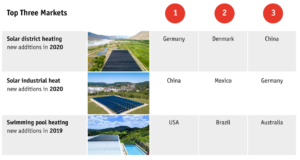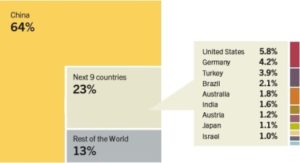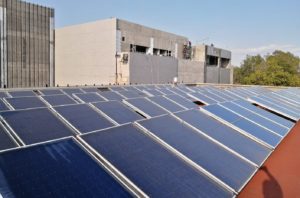“Very few countries have policies explicitly supporting renewable deployment in the industry sector”
March 2, 2015
The International Renewable Energy Agency (IRENA) published two technology briefs last week. The 40-page documents, one entitled Solar Heat for Industrial Processes, the other Solar Heating and Cooling for Residential Applications, give a brief global overview of the market and technology development, including some recommendations for policy makers (see attached documents). It is the first time that the solar thermal sector is in the focus of a technology brief. The studies were published under the Energy Technology Systems Analysis Programme (ETSAP) of the International Energy Agency. Solarthermalworld.org spoke with one of the authors, Ruud Kempener, Technology Roadmap Analyst at the IRENA Innovation and Technology Centre in Bonn, Germany.
Solarthermalworld.org: Last week, IRENA published two technology briefs related to solar thermal technology. What are the objectives of these publications, and will other topics follow?
Kempener: Technology briefs are introductory documents for policy makers, providing an overview of potentials and barriers of a particular technology or application. In 2012/2014, we published a series of ten technology briefs covering different energy sources and applications, for example, photovoltaics and concentrated solar power. The two most recent publications are the first technology briefs in this next series. We are diligent in considering review comments of industry stakeholders, researchers and country-specific experts.
Solarthermalworld.org: Why did you choose solar process heat and not solar thermal in tourism or in the public sector, which are also trendy topics?
Kempener: The long-term goal is to cover all six renewable energies – wind, biomass, solar, geothermal, ocean and hydro – in as many application areas as possible, such as in the power sector, heat sector, in the construction, transport and industry sector. That being said, our resources are limited, so we must focus our energy where it can have the most benefit.
While we were in the process of drafting the REmap 2013, the roadmap for doubling the share of renewable energy in the global energy mix by 2030, we realised that additional measures are necessary in the transport, construction and industry sector to reach a target twice as high. Especially in the industry sector, it became clear that very few countries have policies explicitly supporting renewable deployment. Therefore, we have chosen solar process heat as the first application to be covered by a technology brief. The deployment of renewable technology in the industry sector will be one of the key policy areas of IRENA in the coming years. To support this process, we have developed a technology roadmap for the global manufacturing industry. In June 2014, a summary entitled Renewable Energy in Manufacturing was published for policy makers, and the detailed background study will be launched on 18 March 2015.
Solarthermalworld.org: Is it more difficult to publish a technology brief on solar heating and cooling than on solar PV because of a lack of transparent data from the former?
Kempener: Indeed, solar heating and cooling offers more different technologies and applications than photovoltaics. Also, the development in each country is rather diverse, so it’s more difficult to condense the data for policy makers at global level without providing information which is too superficial in nature.
Solarthermalworld.org: The number of solar process heat installations is still small. What measures do you recommend to increase deployment?
Kempener: We identified a number of major barriers that need to be overcome to achieve a high deployment of solar industrial process heat. There is a lack of marketing models which reduce the risk and the upfront costs for small and medium-size enterprises. Subsidies for fossil fuels in the industry should also be removed to increase the economic viability of solar process heat in many sunbelt countries. In addition, we see a lack of engineering capacities. Only very few suitable design guidelines and tools are available. Last but not least, the economic and practical advantages of solar heat need to be highlighted and this information spread among businesses. If entrepreneurs do not receive first-hand experiences with existing plants, they will tend to consider only fossil fuel-based systems that they are more familiar with.
Solarthermalworld.org: According to the latest survey, 25 % of the relevant solar thermal manufacturers in BRIC countries India, Brazil and China expect solar process heat to be the dominating application among their sales by 2020. Do you see a faster trend towards solar process heat outside than within Europe?
Kempener: When comparing 2007 and 2014 data, we indeed observe that geographical markets and sectors for solar process heat are changing rapidly. Deployment in China, Mexico and, especially, India have grown substantially. We see special opportunities for small and medium-size enterprises in this sector. Although they only account for a quarter of the energy consumption of the industry sector, they account for more than 95% of all companies. They also play an important role in the economic growth taking place in BRIC countries and are vulnerable to changes in energy prices. Deployment of solar thermal process technologies in these countries would provide a reliable and cheap source of energy, and at the same time allow for a massive scale-up, with opportunities for replication, learning and associated cost reductions.
Solarthermalworld.org: What is the assumed long-term potential of solar process heat?
Kempener: For the first round of REmap 2030, we completed around 26 country-specific analyses to identify actions on technology deployment, investment and policy in collaboration with the IRENA members and other key entities. The aggregated results showed an economically realisable potential of 1.3 EJ of solar process heat of up to 200°C worldwide by 2030, which corresponds to 2 % of the total process heat demand.
A collector area of around 800 million m2 would be necessary to achieve this goal. Continued cost reductions, as well as carbon pricing could increase the economic potential to 2.2 EJ or 1.3 billion m2. The Technology Roadmap of the International Energy Agency predicts a solar share of 20 % in the temperature range below 120°C by 2050. An installed solar thermal capacity of 3.200 GWth or 4.5 billion m2 of collector area could make this share a reality.
Solarthermalworld.org: Irena has 130 staff, including trainees and consultants. How is the organisation structured and where do you find the advocacy for solar heating and cooling issues?
Kempener: IRENA as a whole is not organised by technology, but by topics. We have three divisions. The IRENA Innovation and Technology Centre (IITC), based in Germany, provides studies, technology briefs, updates on cost data and potential scenarios. The IITC is also responsible for developing the REmap 2030. Secondly, the Knowledge, Policy and Finance Centre (KPFC) based in Abu Dhabi, a global knowledge repository for statistics on market volumes, employment or investment frameworks. The third institution is also located at IRENA’s headquarters in Abu Dhabi and is called Country Support and Partnerships. It helps countries and regions accelerate the deployment of renewables through various initiatives.
All three divisions have activities that concern solar heating and cooling. Together, they organised a number of meetings, such as the Renewable Energy Applications for Island Tourism last May in Cyprus, at which solar heating and cooling was discussed. The results of these discussions were summarised in a publication on renewable energy options for island tourism. Our division IITC will publish a study on standards, certification and quality assurance in the solar heating and cooling sector, which should be available later this year. And KPFC is about to add solar heating and cooling statistics to the newly launched online research tool REsource.
The interview was carried out by Bärbel Epp.


